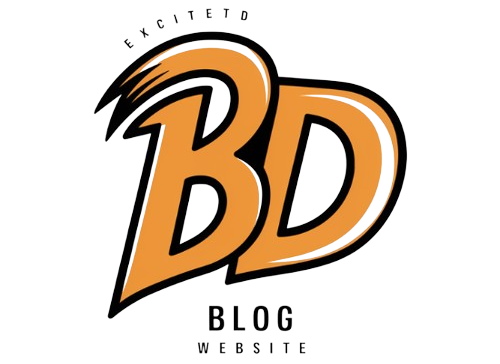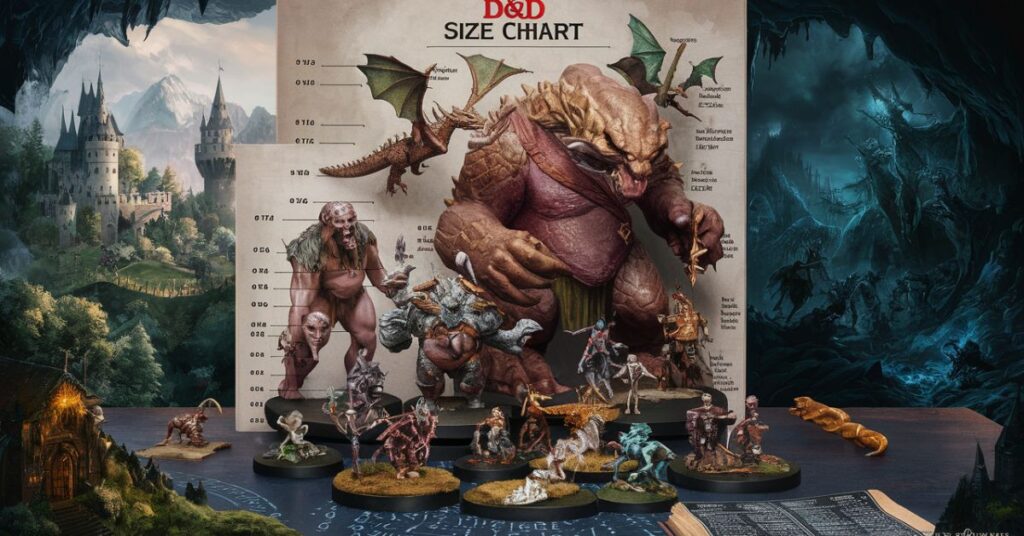The Dnd Size Chart Size Chart ranks creatures and objects by their exact dimensions in height and weight. For this, a system of that nature is necessary to interpret how so many forms of interactions, movement, and gameplay mechanics function within the world of Dungeons & Dragons.
Knowing the secrets of the Size Chart can make all the difference in the world, as it opens up new tactical possibilities to the gamer and immerses him further into the gameplay. Let’s stay with finding out how being a master of these details will raise gameplay to a whole new level of excitement and strategy in every encounter.
What is the D&D Size Chart?
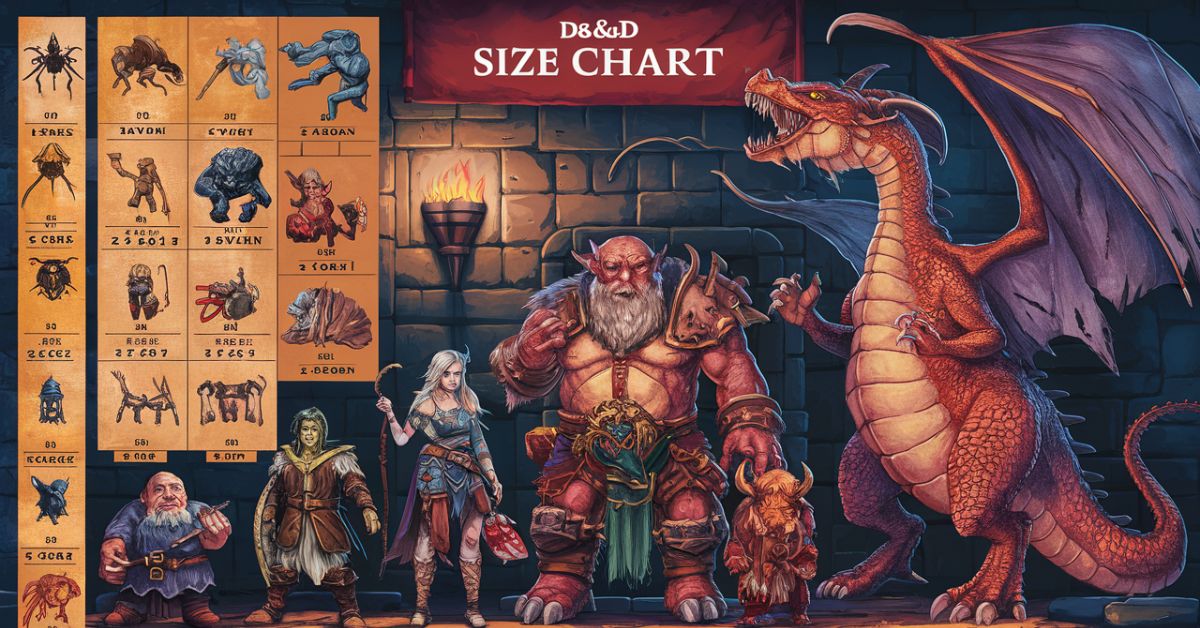
This is essential in this tabletop game, Dungeons & Dragons, for classifying any creature or even an object based on its physical dimensions, usually height, weight, and general measurements. In the chart, there can be six categories that divide it: Tiny, Small, Medium, Large, Huge, and Gargantuan.
These define how much space it occupies, a creature’s reach during combat, and generally how it interacts with the environment. Knowing how the works is vital for both players and a Dungeon Master since it affects movement, combat, or even the amount of weight a creature can carry.
While a Tiny creature like the sprite could move about effortlessly in tight spaces, a Gargantuan creature the dragon holds sway over large areas and may bear loads that are vast with ease. This rating system deepens the realism of the game, allowing for much more vivid immersion and strategic planning in your D&D campaigns.
In learning the D&D Size Chart, you will understand much more of the huge variability of creatures within the realm of D&D and how to use their interesting features in order to further flesh out your adventures.
Read More : Starting a Business in Ontario: Your Ultimate 11-Step Checklist
Exploring the Size Categories
Tiny
Tiny creatures are the smallest in the D&D universe, no taller than 2 feet, no heavier than 8 pounds. Examples include imps and sprites. These tiny creatures can fit into small spaces and often have special abilities that let them escape notice or squeeze through tight spots.
Small
Small creatures are 2 to 4 feet tall and weigh 860 pounds. Examples include goblins and halflings. Though small, these creatures are often surprisingly quick and can move with ease through environments that larger creatures couldn’t navigate. They may not deal as much damage when they hit, but their speed often makes them difficult to hit or catch.
Middle
The most common size of player character is medium, which includes humans, elves, and orcs. Medium creatures stand between 4 and 8 feet tall and weigh from 60 to 500 pounds. This size category represents a balance of strength and agility, allowing medium creatures to move freely in most environments and handle a variety of combat situations.
Large
Large creatures stand anywhere between 8 to 16 feet tall and weigh up to 2 tons. Examples include horses and trolls. For large creatures, a square or area occupied by such is of considerable size on the battlefield, normally covering ground with almost every step, and often their blows are very strong. However, the size can make it hard for them to move around in smaller places.
Here’s a table that summarizes the D&D size categories, including their space requirements, height or length, weight, and examples:
| Size Category | Space Required (ft.) | Height or Length (ft.) | Weight (lbs.) | Examples |
| Tiny | 2.5 x 2.5 | 6 in. – 2 ft. | 1 – 8 | Imp, Sprite |
| Small | 5 x 5 | 2 ft. – 4 ft. | 8 – 60 | Goblin, Halfling |
| Medium | 5 x 5 | 4 ft. – 8 ft. | 60 – 500 | Human, Orc |
| Large | 10 x 10 | 8 ft. – 16 ft. | 500 – 2 tons | Horse, Troll |
| Huge | 15 x 15 | 16 ft. – 32 ft. | 2 – 16 tons | Giant, Dragon |
| Gargantuan | 20 x 20 or larger | 32 ft. or larger | 16 tons or more | Kraken, Tarrasque |
This table provides a quick reference for understanding the different size categories in Dungeons & Dragons, helping players and Dungeon Masters visualize and plan for the unique characteristics and challenges of each size.
Mechanics and Gameplay Implications
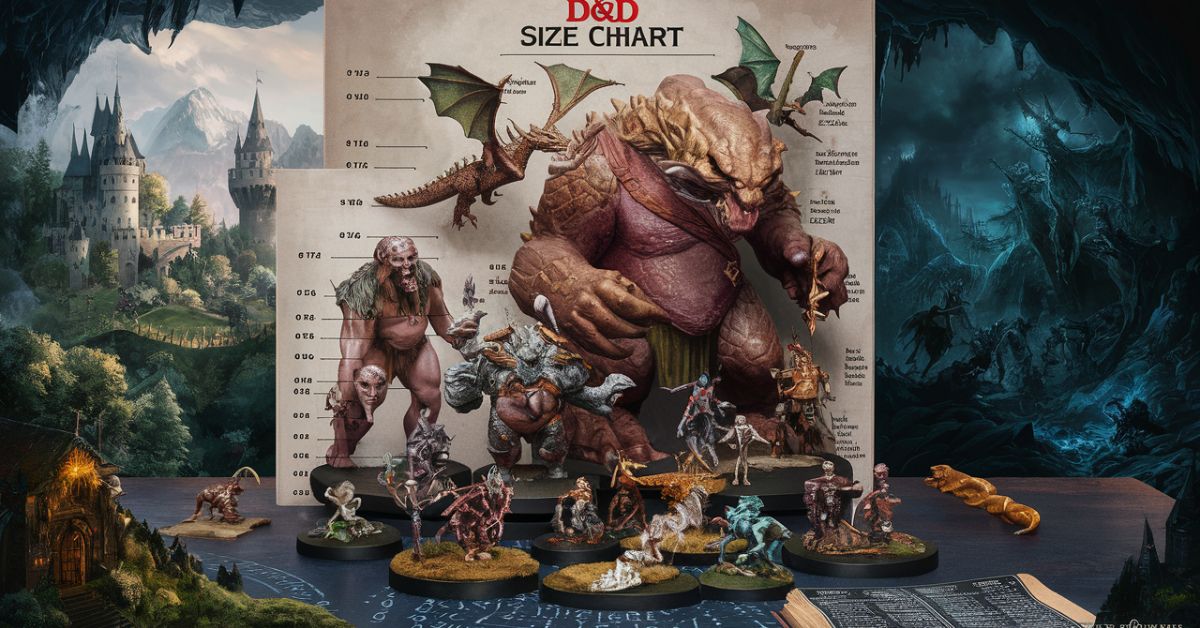
Mastering the mechanics of the D&D Size Chart and the gameplay implications enriches gameplay in any edition of Dungeons & Dragons. It is not just a matter of creature size movement, combat, and environment all get influenced by size.
The bigger a creature, the more real estate it could hold on the field, and the more reach it would have during fights. The smaller a creature, the tighter the places it would fit through, and the more it could avoid detection. These size-based mechanics are hence related to the realization of encounters and strategies at play.
The learning of these details will therefore be highly instrumental in helping players and Dungeon Masters alike create more immersive and dynamic adventures, where the action will be challenging and engaging in every session.
Movement and Reach
In Dungeons & Dragons, the size category of a creature influences its movement and reach. This specifically dictates how the creature moves around in the game world and how it engages in combat.
Movement
Movement defines how far a creature can move in a turn. Larger creatures often have longer strides, increasing their speed. For example, a Large creature might charge across a battlefield or march with fewer footsteps than a Medium or Small creature. On the other hand, larger creatures may have problems moving quickly in cramped quarters, such as narrow staircases or dense forests, where their size becomes a hindrance.
Reach
Reach refers to how far away a creature can make an attack or interact with objects and other creatures. The reach of larger creatures is almost invariably greater, and they can strike from farther away.
A Huge giant would have the reach to swing a weapon or make a melee attack against a creature 15 feet away, while a Medium human would need to close to 5 feet. This extended reach can often be most advantageous in combat, allowing larger creatures to command more space and keep lesser opponents at bay.
Workings
Tactical Combat: The knowledge of movement and reach thus becomes extremely relevant to both players and Dungeon Masters in designing any combat strategy. It would mean that larger creatures dominate open spaces and can work from a distance with their reach, keeping opponents out of the way.
They are, at the same time, offset by smaller creatures that exploit their agility and smaller size by moving through tight areas and remaining out of the way of attacks.
Environmental Navigation: Size would affect how the creatures move in varied environments. Smaller creatures can just slide through narrow passages, slip into small spaces that larger creatures might have to go around or blow their way through.
Grasping the mechanics of movement and reach can empower players to make more sage decisions, as this will allow for an even greater depth of strategy and fun in D&D gaming.
Squeezing and Tight Spaces
Squeeze is a game term in Dungeons & Dragons for being able to press through a pathway that allows you to pass through spaces of a width less than that of your normal spaces. Usually, that’s brought up in the context of exploration, so your character might have to squeeze through constricted spaces like small cracks or narrow tunnels.
A space down to 2.5 feet wide lets a Medium creature squeeze, but it’s usually coupled with penalties, such as slow movement, bad saves, attacks, and checks. It is a real squeeze for a larger creature, though. For example, a Large creature would have to squeeze through a 5 foot corridor, making it impossible for them to neither move nor functionally go into such a narrow space.
Squeezing may add some tactical elements into the gameplay because all the characters need to consider the surroundings and plan the movements carefully. Knowing these constraints, one can design and travel through complicated environments while maintaining encounters and exploration engaging and dynamic.
Carrying Capacity and Encumbrance
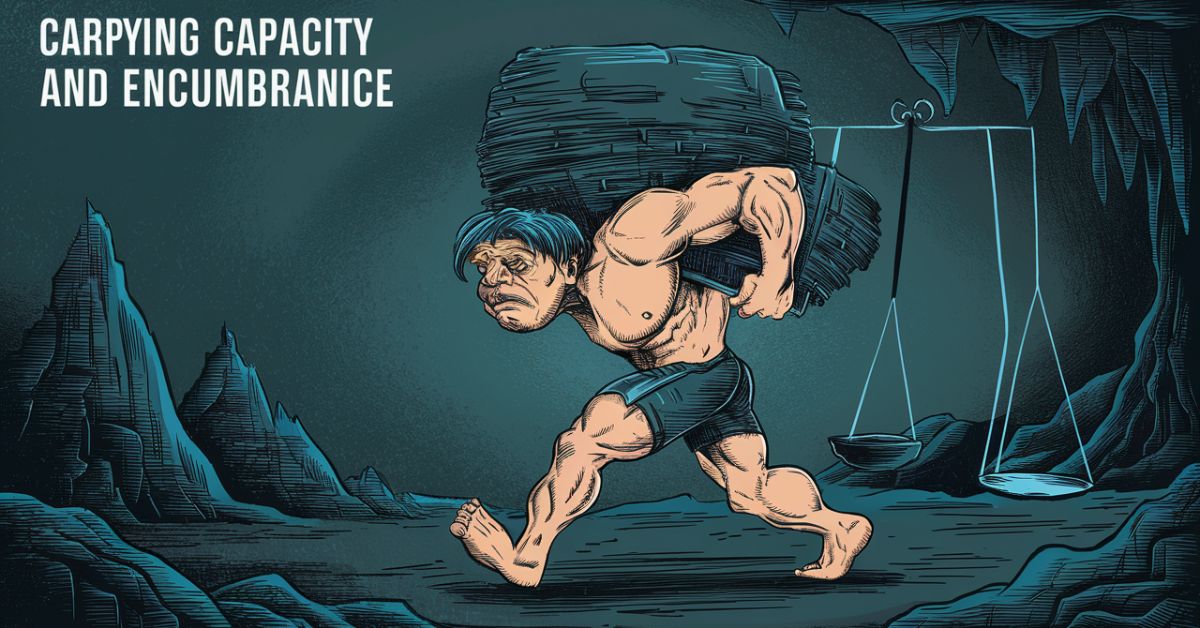
In Dungeons & Dragons, carrying capacity and encumbrance are modified based on a creature’s size. The carrying capacity is tremendously maximized in bigger creatures than the smaller ones. For instance, a Giant might easily carry heavy boulders or large treasure hoards, while a tiny creature, such as a sprite, can carry only very light things. This excess can bring on encumbrance penalties to movement and hinder a creature’s capability, generally, in performing any tasks effectively. This is a critical balance to have in making strategic gameplay, mostly while exploring or collecting loot.
Read More : Camlock Fitting Woes? Your Ultimate Troubleshooting Guide for Industrial Fluid Transfer
Environmental Interactions
Size is also important for environmental interactions. Much larger beings often have difficulty navigating in tight spaces, such as narrow corridors or small chambers, where their mass impedes their mobility. Smaller creatures can exploit these advantages to slip into tight spaces that larger beings cannot, hide more easily from enemies, or move about in environments larger beings can’t. Knowing these dynamics allows players and Dungeon Masters to construct encounters that are much more immersive and varied, where environmental constraints and advantages or disadvantages related to size have a crucial role in the adventure.
Pro Tips for Embracing Size in Your Game
- Varying Encounter Sizes: Mix creatures of different sizes in your encounters to add some variety and challenge. For example, mix a few Small goblins with a Large ogre to set up a dynamic battle scenario. It really strains the tactical skills of players and makes combat exciting and unpredictable.
- Use Size to Your Advantage: Allow the players to strategically make use of size. Larger creatures are going to want to control open spaces and make the most of their reach. Smaller creatures will want to find a place to hide and move through tiny spaces. This adds dimensions to gameplay when this is brought to their attention during encounters.
- Describe the scale: Give details of the effect of the size so that masses and differences in size impress upon the players. Describe how a Huge dragon’s wings create powerful gusts of wind, or how a Tiny sprite flits around obstacles. This kindles immersion and helps to more effectively envision the game world.
- Involve size into puzzles and challenges: Develop puzzles and environmental challenges that consider size. For example, design a room with obstacles that only certain-sized creatures can pass over, or use the size restriction to affect how players solve problems and move around spaces.
- Size Variations Alter Encounters: Encounters are adjusted based on the size of the creatures in question. Adjust things like the difficulty of traps or other hazards because of the size of the creatures, so that huge or tiny creatures have appropriate challenges. This will then balance out the game for all players.
Size Chart Variations and Homebrew Rules

While the D&D size chart provides a very fair and good starting point to classify creatures with size, many DMs and gaming groups have fun tweaking variations of the size chart and homebrew rules to suit their games to taste.
While the official chart contains only such standard categories as Tiny, Small, Medium, Large, Huge, and Gargantuan, homebrew rules can stretch these, or alter them, to fit different campaign themes or gameplay styles.
For example, some DMs include extra size classes, such as Colossal for genuinely huge beings or even Minuscule for creatures smaller than the standard Tiny size.
It can flesh out the game with detail and permit even more extreme variation of size and capabilities for creatures. Changes to the mechanics in the form of movement rates, reach, carrying capacity, and so on can be adjusted for the new size categories or tailored to suit unique campaign settings.
That is, it’s a place where creative customization can be optimally done by size chart variations and homebrewing of the rules to suit the unique needs and preferences of a particular gaming group. Additional size categories or fine-tuned mechanics may both lead to more engaging and tailored storylines that stress a different angle on traditional D&D gameplay.
Conclusion
The D&D Size Chart is a simple tool that furthers the gameplay experience by grouping creatures based on their dimensions in a way that affects movement, combat, interaction with the environment, and nearly everything else. Knowing and using the Size Chart can help both players and DMs to make more vivid adventures. The larger creations pound their way to victory, using reach and brawn to gut the opposition, while little guys squeeze into corners and use agility to victory.
Further variations and homebrew rules will let one tailor the game into what works for groups, so this chart can be adapted to fit special themes in campaigns or difficulties as desired. These elements, embracing both deep strategic gameplay and enriching storytelling in a manner that makes every session of Dungeons & Dragons whirl down the spiral of enjoyment and memories, never tire. From the most standard to the more esoteric aspects of custom rules and regulations, the Size Chart is what stands at the fore, supporting real engagement and encounter balance within the world of fantasy.
FAQ’s
What is the best size for D&D?
There is no single “best” size; it depends on the desired gameplay and narrative.
How big is each D&D size?
Size categories range from Tiny (6 in. – 2 ft.) to Gargantuan (32 ft. or larger).
How big is a Huge 5e?
A Huge creature is between 16 ft. and 32 ft. tall.
How big is a Tiny 5e?
A Tiny creature is between 6 in. and 2 ft. in height or length.
